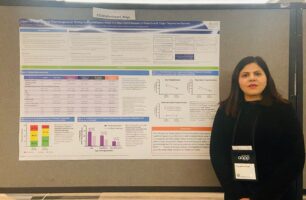This blog summarizes key points discussed during the March 2024 GeneSight® Engage webinar
Participants:
 Bernie Ranchero, MD, MS, MBA, medical director, Leadwell Division Hospital Sisters Health System, Ill. Bernie Ranchero, MD, MS, MBA, medical director, Leadwell Division Hospital Sisters Health System, Ill. |
|
 Debbie Thomas, EdD, APRN, PMHCNS/PMHNP-BC, owner & medical director, Here & Now Psychiatric Services, Ken. Debbie Thomas, EdD, APRN, PMHCNS/PMHNP-BC, owner & medical director, Here & Now Psychiatric Services, Ken. |
|
 Carson Felkel, MD, FAPA, system medical director, Bon Secours Mercy Health, S.C. Carson Felkel, MD, FAPA, system medical director, Bon Secours Mercy Health, S.C. |
In a recent GeneSight Engage webinar, a trio of experts who regularly order the GeneSight Psychotropic test, shared their insights about how they use the information on the report. The panelists explained the practical uses of the report’s ‘Patient Genotypes and Phenotypes’ and ‘Gene-Drug Interactions’ sections. They encourage clinicians to explore beyond the Green-Yellow-Red classifications to unlock the full potential of the GeneSight report for their patients.
Section 1: A tool for busy clinicians
For Dr. Bernie Ranchero, the opening section of the GeneSight report has become an essential, at-a-glance resource.
“I’m taking some of the guesswork out of it and making an educated decision,” says Dr. Ranchero. “…One of the things I’m telling the patients is that I would like to do a test on you where I can individualize, and based on your individual DNA, and based on your genetics we can both make an educated choice. That’s shared decision making.”
“We can make an educated decision before we start instead of saying, ‘Let’s see how you do in six weeks. Let’s see how you do in 12 weeks. Oh, let’s make some dose changes. Oh, let’s switch you over again,’” he continues. “And now six months have passed, and how has that patient’s quality of life been affected?”
Dr. Debbie Thomas appreciates the potential time savings of individualized genetic testing versus a wait-and-see approach.
“For a patient, time ticks a lot slower than it does for us. So, for a patient who is really in depression and really struggling, to tell them we’re going to go ahead and start this, and we’ll do four to six weeks, and if that’s not doing it, come back and maybe we’ll increase it or maybe we’ll switch. So those four weeks to that person, is like a day of our life goes by, they’re counting minutes,” says Dr. Thomas. “…I always want to keep that in mind… And I just think that [the GeneSight report] is one of the best things I’ve ever had to offer patients.”
Dr. Carson Felkel used the sample report displayed during the webinar to provide an example of how the GeneSight report can help inform providers when prescribing medication.
“If you’re primary care, or even psychiatry or in an OB/GYN practice or cardiology, and your ‘go-tos’ are Lexapro, Celexa, Wellbutrin… look, these are in the red [column of the report]. This Is a tough report,” says Dr. Felkel. “…They have a problem at 2C19 and 2B6 and the serotonin gene, and it’s pushing everything to the red that we typically go to first line and so in that case we probably don’t want to go to this first line. And how else would we know that?”
Many FDA-approved medications are metabolized through multiple pathways, which makes the insights found in the GeneSight report valuable for clinicians.
“The thing about the GeneSight test that I really appreciate and like a lot is the combinatorial approach,” says Dr. Thomas. “It’s not single-gene testing. It’s the combinatorial approach. And that algorithm that’s used, I don’t have to explain that to somebody… but I can understand it enough to share with a patient why this makes sense. When you look at maybe 3A4 metabolizes a little bit, so it gets a little slot. Maybe it’s mainly metabolized by 2C19 so it gets a bigger ball in the court… Obviously clinical judgment always has executive veto power, we take all the things into account, but now we can make sense of it and explain it in a way that is logical to them.”
Section 2: Going further and exploring the ‘why’
According to the panel, the Interpretive section of the GeneSight report can be a tremendously valuable resource, providing actionable insights that help inform a clinician’s medication selection and dosing. The Clinical Considerations listed at the bottom of the Green-Yellow-Red pages provide general rationale for a medication’s classification, and the report’s subsequent two sections go further to explain why certain medications were classified as they were and why medications received clinical considerations.
For Dr. Thomas, the second section of the report, ‘Patient Genotypes and Phenotypes,’ is an immensely helpful and practical tool.
“When I’m explaining to new providers, just simply, I look at genotype as kind of the ingredients or the recipe ingredients for the cake, and the phenotype is the cake, what shows up. …It’s not just the gene; it’s the gene and other environmental factors, other things we put into our body,” says Dr. Thomas. “…People will come into our office and say, ‘I’d like to try this medicine because it worked for my sister.’ So, sometimes I’ll explain to them and to my colleagues that just because a family member has this set of genes and this med worked for them, that doesn’t mean, because you’re her sister that you’re going to have the same response to medication.”
This section’s two pages, ‘Pharmacodynamic Genes’ and ‘Pharmacokinetic Genes,’ provide information on the genes tested, helping explain why patients — even related patients — may respond to medications or metabolize medications differently.
“Taking all of the science and making it practical for the patient, it helps them not to feel [like this is their fault]… It’s a collaborative approach with our patients… It helps them to understand the reasons that we’re doing this,” says Dr. Thomas.
Dr. Felkel cites a formative experience treating a young patient who was struggling with severe OCD and depression. When multiple medications had failed, a GeneSight report was conducted during a hospitalization and it revealed that he was a poor metabolizer for multiple pharmacokinetic genes, and his prescribed doses of fluoxetine (Prozac®), sertraline (Zoloft®), and clomipramine may have been too high. Upon reviewing the pharmacodynamic and pharmacokinetic genetic results in his patient’s report, and taking into consideration the other clinical factors pertaining to the patient, the provider decided to prescribe duloxetine (Cymbalta®).
“He went into a full-fledged remission,” says Dr. Felkel. “Back to work as a 15-year-old, at this time,. No OCD. Full remission. And I was left feeling really guilty. And so that really is what opened my eyes to [the GeneSight report], and I just started learning from there.”
The information in ‘Patient Genotypes and Phenotypes’ provides information to help understand why medications are categorized as Green, Yellow, or Red with certain Clinical Considerations in the first section of the report. For a deeper dive into this section and to help you become more comfortable interpreting the report, our team of MDs, PharmDs, and PhDs are available upon request. Additionally, the GeneSight test has a Clinician Report Interpretation resource available here.
Section 3: The gene-drug interaction chart helps you better understand medication metabolism
The gene-drug interaction chart provides supplementary information about which pharmacokinetic genes are involved in the metabolism of each medication on the report. The chart is intended to augment the patient results on the pages where the medications are categorized and the clinical considerations are provided, which serve as the primary resource to help inform treatment decisions. According to Dr. Felkel, the chart contains important information.
“I certainly use it every time,” says Dr. Felkel of the chart. “…There’s a lot of tools out there, but this is your quick tool because it also reminds you at the top horizontally what pathway is impaired.”
To demonstrate how he uses the ‘gene-drug interaction’ chart, Dr. Felkel shared an example involving propranolol and Prozac.
“Let’s say they have PTSD,” he says. “Still have a lot of hypervigilance, kind of that cortisol rush, and I’m going to add on a beta blocker, propranolol, to my Prozac. Well, I need to remember, what pathways does my Prozac go through? …You can see here, fluoxetine (Prozac), second in the yellow column, goes through 2C19, where there’s a problem, 2C9, 2D6, and 3A4. Circles [on the chart] mean it goes through that pathway. A filled-in circle means there’s a variant allele there. So now imagine that my Prozac, which I know is going through 2D6, it’s also a 2D6 inhibitor so it’s inhibiting itself. And now let’s say the patient’s a poor 2D6 metabolizer. I’m not going to use propranolol.”
“These dotted pages,” Dr. Felkel continues, “the more you look at them, this is our best estimate of how to reduce polypharmacy and/or create rational polypharmacy, avoiding medicines going through the same pathways, especially when they’re impaired.”
Dr. Thomas once again emphasizes the importance of the GeneSight test’s combinatorial approach. “I want to know that information. Not just a single gene. I can look at 15 single genes, but I want to know all those together and how they’re weighted out, to look at those variants, because that’s what informs those Clinical Considerations in the first part of the report.”
“It just makes sense,” she says.
For more information on this topic and how the GeneSight test may help, visit:
[GeneSight website links]
Watch this GeneSight Engage webinar in its entirety:













